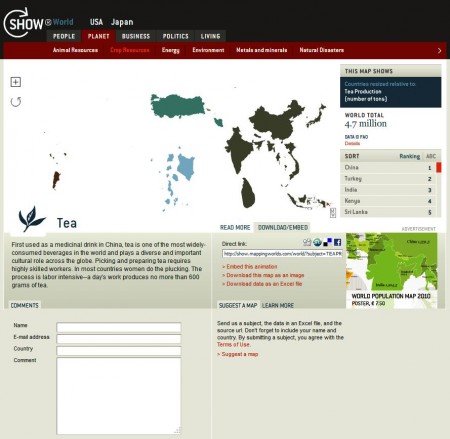I love the animated maps of crop and livestock production in different countries at Show®World. But has anyone been able to embed them, or even download the images? Because I haven’t. And this screengrab is pretty lame by comparison.
Nibbles: Cornish pasties, Rice and fish, Wheat breeding, Diatribe, Hops, Bean-To-Bar, Geographic indications
- Yes, because the world desperately needs a map of “handheld, filled snacks from around the world.”
- Paddies and aquaculture go well together. But didn’t we know that already? And wait, synergise is a verb?
- Article with interesting-sounding title about the use of IT to monitor wheat diseases has nothing to do with using IT to monitor wheat diseases.
- Oh that’s enough for today, I’m just not in the mood. As you might have noticed.
- No, wait, I feel better now. Ah, the restorative power of beer and genebanks.
- And of chocolate.
- Which does not feature among the first three African PGIs.
Brainfood: Vinecology, African veggies, Land abandonment, Wheat special collection, Altitude and diversity, Persistence and diversity, Intensification, Rainfall and fruit, Mosaic tree
- Vinecology: pairing wine with nature. You can have wine, and drink it too.
- The role of wild vegetable species in household food security in maize based subsistence cropping systems. Is very significant, in South Africa.
- Does land abandonment decrease species richness and abundance of plants and animals in Mediterranean pastures, arable lands and permanent croplands? Well, we wont know until these guys do their review, as described here. What a weird paper.
- Development of a core collection of Triticum and Aegilops species for improvement of wheat for activity against chronic diseases. Used GRIN to select material from areas varying in cancer prevalence.
- Patterns of Genetic Variation across Altitude in Three Plant Species of Semi-Dry Grasslands. Populations on the edge altitudinally are not on the edge genetically.
- Is community persistence related to diversity? A test with prairie species in a long-term experiment. Yes. If by persistence you mean that the community resists invasion better after you stop weeding it.
- Agricultural intensification in Brazil and its effects on land use patterns: An analysis of the 1975-2006 period. Intensification leads to decreased expansion only where land is scarce, i.e. NOT at the frontier.
- Long-term Changes in Fruit Phenology in a West African Lowland Tropical Rain Forest are Not Explained by Rainfall. I don’t get it. Maybe someone can explain it to me.
- Differences in gene expression within a striking phenotypic mosaic Eucalyptus tree that varies in susceptibility to herbivory. One tree, 2 chemotypes, many genes differentially expressed, 10 SNPs that could affect secondary metabolism.
Nibbles: Organic tomato goodness, Golden Rice timeline, Beet nutrient changes, Finger millet intensification, Apple pix, Sourdough fungi, Rotational goodness, Bioversity DG, World Food Prize
- Another view of that organic tomatoes, stress and nutrients study that was all over the place yesterday.
- IRRI provides a reality check on Golden Rice. Maybe they should just have stressed it.
- Speaking of which, have we already linked to this piece on how beet has got poorer in nutrients?
- Thinking of setting up a map portal? Say about the geographic distribution of nutritional problems? Read this first.
- From SRI to SFMI. Yeah, but what is happening to nutrient levels?
- Did we also link to these pretty photos of apples before? Well, I don’t care, it’s worth seeing them again. And just imagine how much the different varieties differ in nutrients.
- How nutritious is sourdough anyway? Anyone?
- Yeah, yeah, but is rotation good for nutrient content?
- Which will all be very interesting to the new Bioversity DG, no doubt.
- Not to mention to some of the potential candidates for the World Food Prize.
Brainfood: Cotton hybrids, Lentil drought phenotyping, Wild Prunus, Italian food discourse, Disturbance and diversity, Olive domestication, Rhizobium diversity, Intensification, Niche model uncertainty
- Interspecific hybridization in Gossypium L.: characterization of progenies with different ploidy-confirmed multigenomic backgrounds. They can be made, with some difficulty, and could be useful.
- A new phenotyping technique for screening for drought tolerance in lentil (Lens culinaris Medik.). In hydroponics. Seems to work.
- Polyploidy and microsatellite variation in the relict tree Prunus lusitanica L.: how effective are refugia in preserving genotypic diversity of clonal taxa? The island populations are particularly important.
- Trade-off or convergence? The role of food security in the evolution of food discourse in Italy. The food crisis had quite an impact.
- Diversity loss with persistent human disturbance increases vulnerability to ecosystem collapse. Suppression of fire in a species-rich grassland has resulted in a very low diversity but highly productive vegetation. Unfortunately, when you re-introduce fire, the whole thing collapses.
- The complex history of the olive tree: from Late Quaternary diversification of Mediterranean lineages to primary domestication in the northern Levant. Don’t forget the 3 refugia in Middle East, Aegean and Gibraltar. And, coincidentally, more.
- Isolation and characterization of salt-tolerant rhizobia native to the desert soils of United Arab Emirates. I hope someone conserves them.
- The compatibility of agricultural intensification in a global hotspot of smallholder agrobiodiversity (Bolivia). Peaches for cash didn’t do anything nasty to the diverse maize landraces. Which are in any case conserved ex situ, just to be on the safe side? Right?
- Detrital diversity influences estuarine ecosystem performance. Diverse mud makes for healthier seagrasses and mangroves.
- Conservation Planning with Uncertain Climate Change Projections. Gotta look at those sensitivities.
